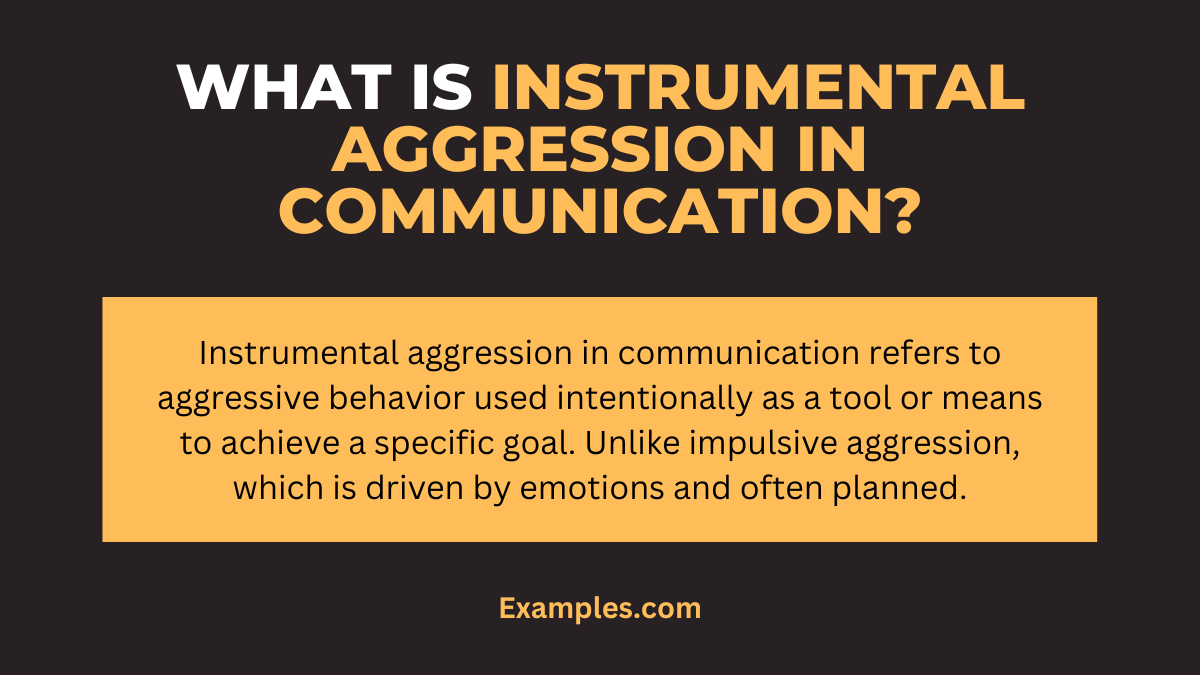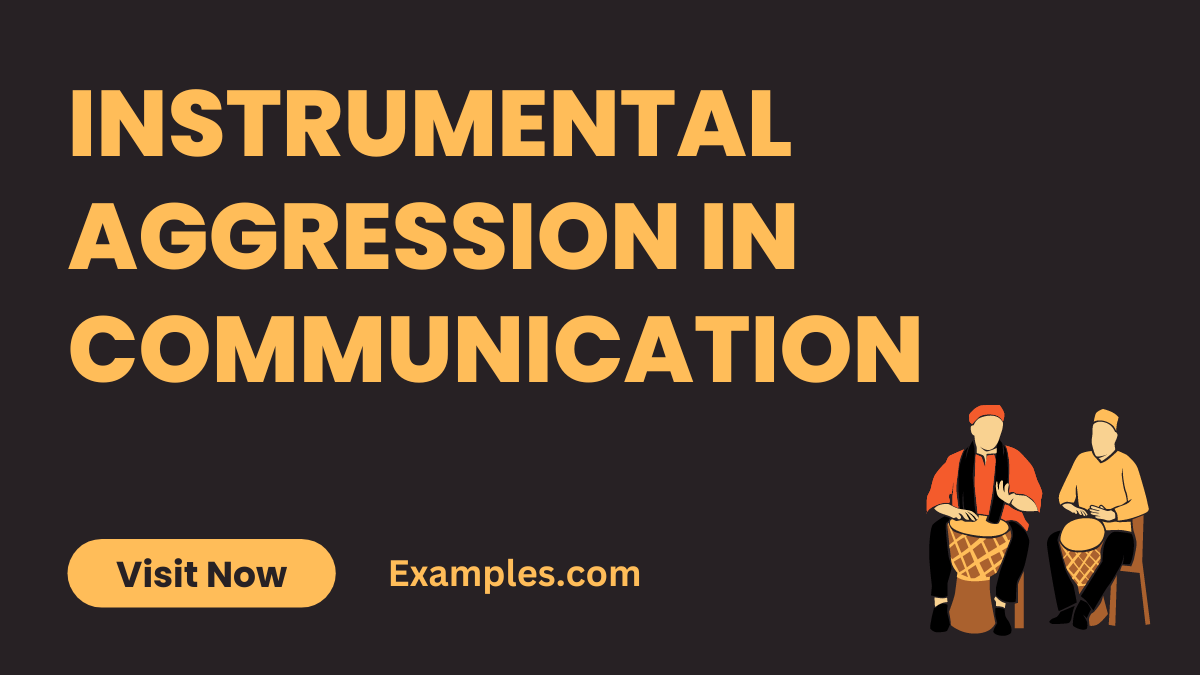19+ Instrumental Aggression in Communication Examples
Instrumental Aggression in Communication offers an in-depth exploration into a distinct type of aggressive behavior often observed in various communication contexts. This comprehensive guide delves into the nuances of instrumental aggression, providing real-life examples and practical insights. It uncovers how this form of aggression is purpose-driven, used as a means to achieve specific goals rather than arising from emotional responses. Essential reading for those seeking to understand the dynamics of power and control in communication, this guide also offers valuable strategies for recognizing and managing such interactions effectively, both in personal and professional settings.
What is Instrumental Aggression in Communication?

Instrumental aggression in communication refers to aggressive behavior used intentionally as a tool or means to achieve a specific goal. Unlike impulsive aggression, which is driven by emotions, instrumental aggression is calculated and often planned. This type of aggression includes behaviors like intimidating or threatening someone to gain compliance or control in a situation. The key characteristic of instrumental aggression is its purposeful nature, where the aggressor uses it as a strategy to obtain what they want or to achieve a particular outcome.
20 Instrumental Aggression in Communication Examples
Instrumental aggression in communication often involves using assertive or forceful language to achieve specific objectives, sometimes at the expense of others’ feelings or rights. Each example is accompanied by a concise explanation, demonstrating how such communication manifests and the impact it can have on both the speaker and the recipient. Understanding these examples is crucial for identifying and addressing instrumental aggression in daily interactions, fostering a more empathetic and effective communication environment. The guide serves as a valuable tool for professionals and individuals alike, aiding in the recognition and improvement of communication dynamics.
- “Do this now, or there will be consequences!” – A manager uses a threatening tone to ensure immediate compliance from their team, prioritizing task completion over respectful communication.
- “If you don’t finish this project, I’ll find someone who can.” – A team leader employs intimidation to push a team member to meet a deadline, disregarding their well-being.
- “I need this report by tomorrow, no excuses.” – A supervisor insists on a tight deadline, ignoring the team member’s current workload.
- “Make sure this error doesn’t happen again, or it’s your job on the line.” – A boss uses fear of job loss to prevent future mistakes.
- “Fix this issue immediately, or you’ll hear from me again!” – A customer uses a threatening tone to ensure their complaint is taken seriously.
- “I expect better results next time, or I’ll reconsider your position here.” – A leader pressures an employee by implying potential job loss.
- “Do as I say, or you’ll regret it.” – An individual uses coercion to gain compliance in a personal relationship.
- “Meet these targets, or I’ll have to find someone who can.” – A sales manager uses pressure tactics to motivate the team.
- “If you don’t agree to these terms, we’ll take our business elsewhere.” – A client employs a forceful negotiation strategy.
- “Complete this task by end of day, or I’ll report your performance.” – A colleague uses threats to ensure cooperation.
- “You better have a good explanation for this mistake, or else.” – A supervisor communicates with a tone of intimidation.
- “Handle this problem now, or I’ll escalate it to your supervisor.” – A coworker uses the threat of escalation to get immediate action.
- “Either improve your attitude, or find another job.” – An employer sets a strict ultimatum for behavioral change.
- “Finish this work first, or forget about your leave request.” – A manager controls an employee’s leave approval based on work completion.
- “Resolve this issue, or it’ll reflect badly in your review.” – A superior links problem-solving to a negative performance review.
- “Change this design by tomorrow, or it’s back to the drawing board.” – A project leader sets a non-negotiable deadline for revisions.
- “If this isn’t done by Friday, don’t bother showing up on Monday.” – An employer uses the threat of job termination for motivation.
- “Agree to these conditions, or the deal is off.” – A business partner adopts a hardline stance in negotiations.
- “Submit this application by the deadline, or you’re not getting another chance.” – A teacher sets strict rules for a student’s submission.
- “Either follow my instructions exactly, or find a different team to work with.” – A team leader gives an ultimatum to ensure adherence to their methods.
Examples of Instrumental Aggression in Communication for Adults
Instrumental aggression in communication among adults often appears in scenarios where achieving a specific goal is paramount. These examples reveal how adults might use aggression to assert control, influence others, or achieve desired outcomes in various settings.
- “Do this now, or there will be consequences!” – Using threats to ensure compliance.
- “If you don’t agree with me, you’ll regret it.” – Imposing views through intimidation.
- “I need this done, no matter what it takes.” – Prioritizing outcomes over ethical considerations.
- “Make them do it, or they’re off the team.” – Exerting control to achieve objectives.
- “You will follow my orders, or you’re fired!” – Using position power to enforce actions.
Examples of Instrumental Aggression in Communication for Children
In children, instrumental aggression in communication can manifest in ways that seek to control situations or achieve specific outcomes, often reflecting learned behaviors or responses to frustration.
- “Give me that toy, or I won’t be your friend!” – Using threats to gain possession.
- “Do this for me, or I’ll tell on you.” – Manipulating to achieve a desired result.
- “If you don’t play this game, you can’t play with us.” – Excluding others to control play scenarios.
- “I hit him because he wouldn’t do what I said.” – Justifying physical actions for control.
- “You must be my partner in this game, or else!” – Demanding compliance in social settings.
Examples of Instrumental Aggression in Communication for Sports
In sports, instrumental aggression can be a tactic used to gain a psychological edge, control the game’s pace, or intimidate opponents.
- “If you can’t handle the pressure, quit the team!” – Using pressure to motivate performance.
- “Play rough to make them afraid.” – Employing intimidation tactics.
- “Win at all costs, even if you have to bend the rules.” – Prioritizing victory over fair play.
- “Make them feel uncomfortable on the field.” – Using psychological warfare to gain advantage.
- “If they push you, push back harder!” – Advocating for physical aggression to dominate.
Hostile Instrumental Aggression in Communication Examples
Hostile instrumental aggression in communication involves using aggressive tactics to harm, control, or demean others, often to assert dominance or influence outcomes.
- “I’ll make sure you never work in this industry again!” – Threatening professional harm.
- “Keep up this attitude, and you’ll see what happens!” – Using threats to control behavior.
- “Mess with me, and I’ll ruin your reputation.” – Threatening personal harm for control.
- “You’re either with me or against me!” – Creating a hostile environment for compliance.
- “Disobey me, and face the consequences.” – Using fear to enforce authority.
What are the Causes Of Instrumental Aggression in Communication?

Instrumental aggression in communication often arises from specific underlying causes:
- Goal Achievement: Aggression can be a strategic choice for achieving specific objectives, especially in high-stakes or competitive environments.
- Learned Behavior: Aggressive communication can stem from behaviors learned from influential figures in one’s life, such as family members, peers, or cultural norms.
- Frustration: Aggressive communication often arises in situations where an individual feels their goals are being thwarted. This frustration can stem from various sources, such as organizational obstacles, personal conflicts, or unmet expectations.
- Perceived Threats: When individuals feel threatened, whether physically, socially, or psychologically, they may use aggression as a defense mechanism.
- Lack of Communication Skills: Sometimes, aggressive communication is the result of insufficient skills in expressing oneself effectively. Individuals lacking in emotional intelligence or adequate communication techniques might default to aggression as a way to make their voices heard.
Understanding these underlying factors can help in addressing and mitigating aggressive communication styles.
How to Use Instrumental Aggression in Communication?
Instrumental aggression in communication is a deliberate strategy used to achieve specific goals, often at the expense of others.
To effectively use instrumental aggression in communication, it’s essential to apply it strategically and ethically:
- Identify Clear Objectives: Before engaging in aggressive communication, be clear about what you hope to achieve. This ensures that your approach is goal-oriented rather than just an expression of anger or frustration.
- Assess the Situation: Carefully evaluate the context to determine if an aggressive stance is necessary. Sometimes, a situation may call for a more subdued approach.
- Maintain Ethical Standards: It’s crucial to ensure that your communication, while aggressive, does not cross ethical boundaries or cause undue harm to others. Respect and integrity should guide your interactions.
- Use Assertive Language: Clarity and directness are key components of assertive communication. This involves stating your needs and opinions confidently without being offensive or disrespectful.
- Control Emotional Responses: Aggressive communication can often be driven by impulsive emotions. Keeping these in check ensures that your actions are calculated and aligned with your objectives.
- Be Prepared for Resistance: Anticipate that your aggressive stance might be met with opposition or conflict. Being prepared for this can help you navigate the situation more effectively.
By following these guidelines, you can use instrumental aggression in communication more effectively, ensuring that it serves a purpose and is executed with respect and consideration for others involved.
Tips for Preventing Instrumental Aggression in Communication
Here are the tips for preventing instrumental aggression in communication:
- Develop Emotional Intelligence: Enhance your ability to understand and manage your emotions. Being aware of emotional triggers can prevent aggressive responses.
- Practice Assertive Communication: Assertiveness involves expressing yourself openly and honestly while respecting others. It’s a balanced approach that avoids aggression.
- Enhance Empathy: By understanding and appreciating others’ viewpoints, you’re less likely to respond aggressively and more likely to communicate constructively.
- Conflict Resolution Skills: Learning effective conflict resolution techniques can help in addressing disagreements without resorting to aggression.
- Encourage Team Collaboration: Promoting a cooperative work culture reduces competitiveness that can lead to aggressive behavior.
Adopting these strategies can significantly reduce the use of instrumental aggression in communication, leading to healthier and more effective interactions.
In the realm of communication, instrumental aggression often emerges as a method to achieve specific goals. However, it’s crucial to recognize that while it can be effective in the short term, it often damages relationships and hinders constructive dialogue. Balancing assertiveness with empathy and respect is key to maintaining healthy communication dynamics. By understanding and addressing the underlying causes of instrumental aggression, individuals and organizations can foster a more collaborative and less confrontational environment.



